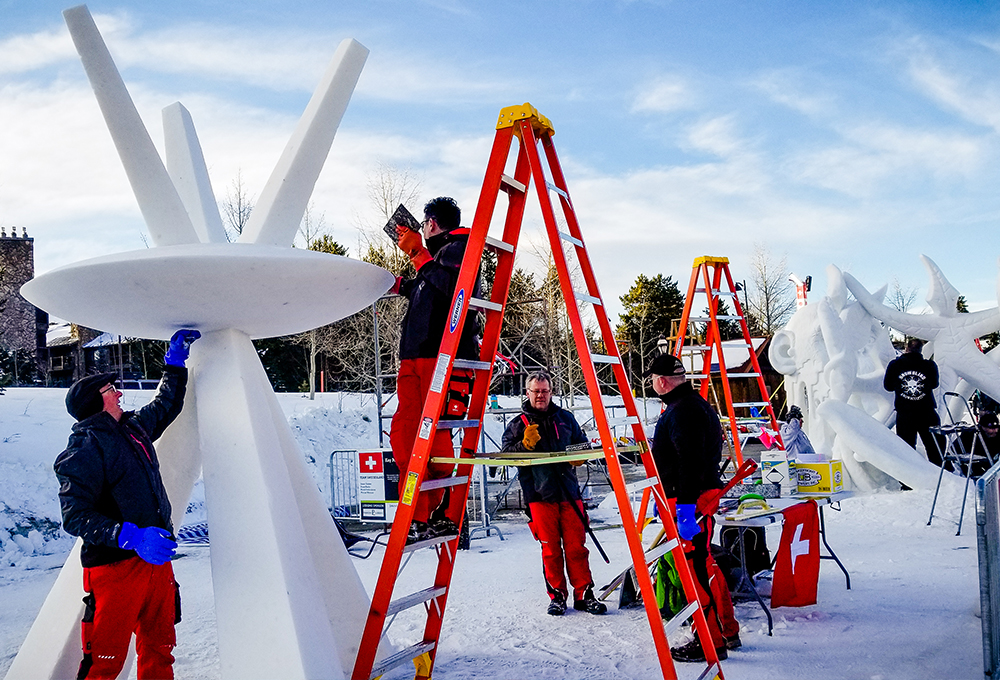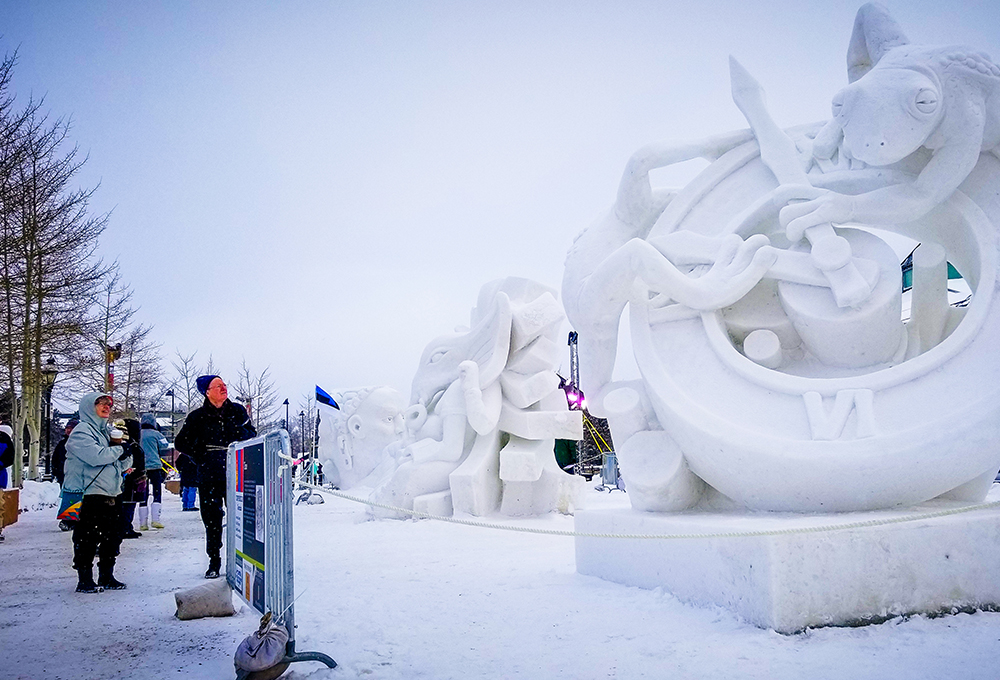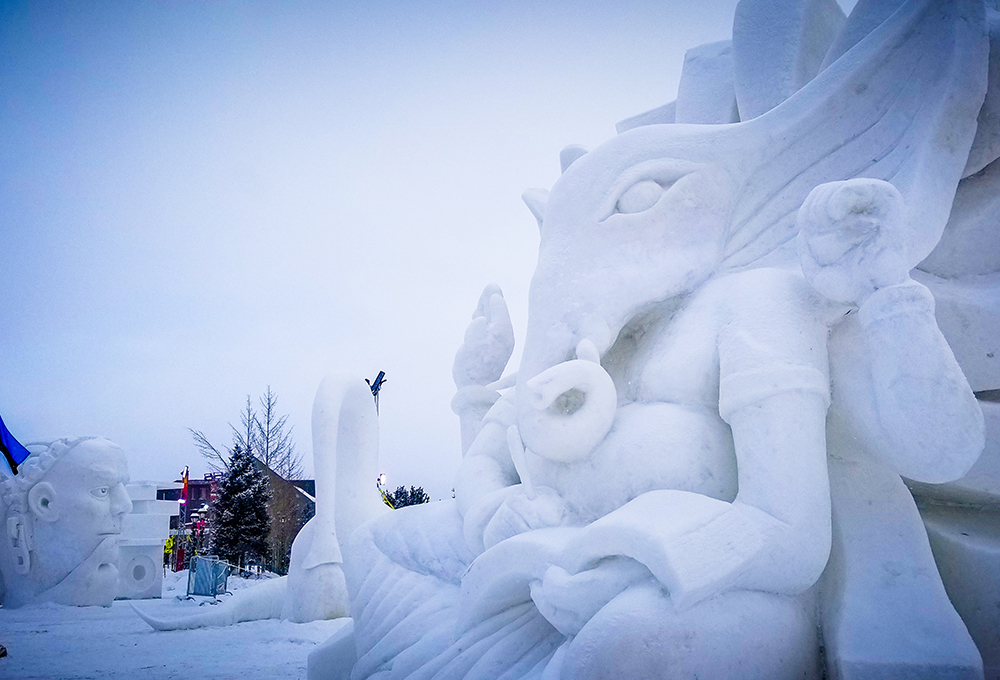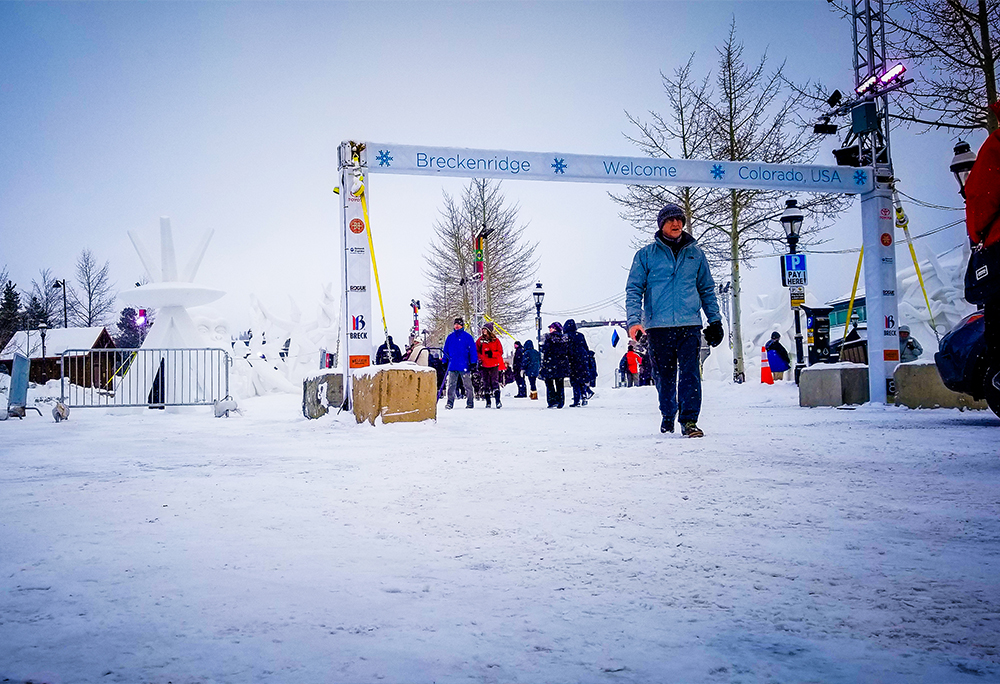Watch the video to see sculptors transform 12-foot tall blocks of snow into artistic masterpieces!
For more than twenty years, Breckenridge, Colorado, has played host to the International Snow Sculpture Championships, which brings teams from all over the world together for five days in January to shape, carve, and sculpt enormous blocks of snow. In 2018, teams from as far away as Mongolia and Argentina ventured to this mountain town for the opportunity. According to Austyn Dineen, the director for the Breckenridge Tourism Office, the Snow Sculpture Organization Committee sends out 250 invitations in June and, in August, requests sculpture proposals from the artists. Of the 250 invites, just sixteen teams are chosen to compete.
It’s not just the chance to create that brings these artists together, though—it’s forging a bond through their love of this little-known medium, learning from peers with completely different points of view, and, most important, pushing the limits of what’s possible.

FIFTY THOUSAND POUNDS
The town of Breckenridge is known for its snow—it’s one of the most popular skiing destinations in the entire world, after all. But even for this snow-covered town, maneuvering four hundred tons of the stuff in a short period of time is a challenge.
It takes a few days to mold fifty thousand pounds of snow into uniform blocks that are approximately ten feet wide by ten feet thick by twelve feet high. With the help of the Breckenridge Public Works Department and volunteers (who are responsible for, quite literally, stomping the snow into place), every team is left with the perfect canvas to shape its creation. Innovators in the field come armed with their own set of tricks and tools—scraping, cutting, and carving away at these blocks until they become the masterpieces that their minds have conjured up.

None of this would have been possible, though, if it weren’t for the vision of the staff at a local real estate group who, in 1979, came together as Breckenridge’s first snow-sculpting team. The team, made up of Rob Neyland, Ron Shelton, Randy Amys, and Bill Hazel, worked with the city to bring in talent from around the world in what would later become the first international championship in 1991.
Since then, the town has become a haven for snow sculptors and is dedicated to making the experience memorable, not only for those competing but also for those who come to admire the work. “The setting could not be more perfect,” says Brett Tomczak, a longtime competitor from Wisconsin. “Breckenridge takes really good care of us.”
CARVING CAMARADERIE
It’s no secret that snow sculpting is a niche portion of the art world. Most people might not even know that it exists outside the realm of snowmen. But, like any other creative outlet, the artists are fully committed to their craft and are constantly revolutionizing what it means to create art out of snow.

As a part of Team USA Wisconsin-Tomczak—one of two teams from the state, and one of five American teams—Tomczak has been snow sculpting on the international level for more than twenty years, though it was a path he nearly passed up. “I kind of fell into snow sculpting,” he admits. “A friend called me up one day and asked if I wanted to join his snow sculpting team that was going to be entering a competition at a local winter carnival. I grabbed anything I could find—some bowls and a few spoons—and decided to see what I could do.”
Tomczak’s team ended up taking third place, and he instantly fell in love with the idea. He has been competing ever since. He has also, for the most part, been competing with the same group of sculptors and has been lucky enough to be invited to the international championships for the last few years.
His team’s collection of sculpting tools has evolved well past spoons and bowls over the years, though. The only things that cannot be used at the international competition are heat and power tools, so competitors are able to get pretty creative with their strategy. In 2018, Tomczak said his team upped its game by bringing snow-specific sculpting tools they purchased from China that are designed to chip away at the block delicately and precisely. The team also frequently uses a roofing shovel, a six-pronged ice pick, a horsehair brush, and sandpaper.

Even with all of the tools at their disposal, it seems that the creation of these gigantic frozen sculptures would be near impossible without a carefully coordinated plan, though Tomczak notes the 2018 competition was the first time his team utilized a to-scale model of its sculpture. In other years Team USA Wisconsin-Tomczak came to the competition with drawings of the front of its sculpture and simply improvised the rest, Tomczak says.
“Historically, most teams have a model of their sculpture with details on all four sides,” he says. “But we are very organic and fluid with our process. This year, when we decided to use a model, we thought it would be easier, but it was actually a lot harder than we thought.” For their 2018 project, Tomczak’s team decided on a ballerina who would stand in a pirouette position with a circular ribbon wrapped around the outside of the sculpture—an ambitious undertaking, Tomczak admits, being their first time working to scale and with an entirely new team member.
Unfortunately, the team eventually pushed the sculpture a little too far, and it collapsed before the judging phase of the competition. “We never had a piece fall before,” says Tomczak. “We knew this year our concept was really fragile, but if you want a chance to get on the podium, you have to push yourself. If it falls, well, then you know you pushed too far.”
Though the sculpture did not hold up for judging, Tomczak says its misfortune was a true showcase of the camaraderie at this event. Members of nearby Team Mexico immediately ran over after the incident to offer assistance and to check on their safety.

THE JUDGING
With fifteen teams left standing, voting commenced to decide on a winner in five categories: Gold, Silver, Bronze, Artists’ Choice, and Kid’s Choice. The Gold went to Team Mongolia-Erdene for its sculpture titled Secret, Silver was awarded to Team China, while the Bronze was awarded to Team USA Wisconsin-Vogt. The Artists’ Choice medal—decided by peer vote—went to Team Mongolia-Tserendash, and the Kid’s Choice was also awarded to Team China.
The community of snow sculptors that has formed out of these events is truly supportive and, even more important, just fun, Tomczak notes. While many people can’t comprehend the point of spending countless hours on a piece of artwork to let it melt away a few days later, he says that the real meaning is in what the experience at large can bring you.
“Just because there’s not a clear end in sight for what you’re creating doesn’t mean you shouldn’t do it. I love the idea that ‘the things that make us weird as children make us interesting as adults.’ Whatever you’re doing—if you’re enjoying yourself while doing it—that’s reason enough.”
For more info, visit gobreck.com.
Up Next:
Experience the Best of Winter Travel
Share the magic of this winter spectacle with family and friends on social media.
